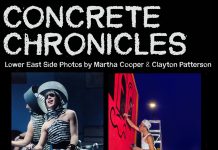
Editor’s note: Tomorrow night, the Tenement Museum will be hosting an opening reception for Rebecca Lepkoff’s “Life on the Lower East Side,” photographs from 1937-1950. Last October, we interviewed Lepkoff in advance of a remarkable group show at the Jewish Museum. Today we’re re-posting that story.
Photographer Rebecca Lepkoff recalls a time when the streets of the Lower East Side were like a theater. “There was always something happening… life took place on the street,” she says.
Lepkoff, 96, grew up in a tenement at 60 Hester St. that no longer exists, and was always fascinated with the streets of her youth. Her black and white photographs depict scenes from a neighborhood that has all but vanished—girls skipping rope in the street; people gathered in front of the Loew’s Canal theater before a show; stoop-sitting and sharing gossip; women hanging laundry on clotheslines strung between buildings.
Lepkoff’s photographs have appeared in numerous galleries and museum shows as well as in A History of Women Photographers by Naomi Rosenblum; Bystander: A History of Street Photography by Joel Meyerowitz and Colin Westerbeck; Street Gangs by Sandra Gardiner and Life on the Lower East Side: Photographs by Rebecca Lepkoff, 1937-1950 by Peter Dans and Suzanne Wasserman. Watch a slideshow we prepared, highlighting some of some of her work by clicking on this link (the photos are courtesy of the Howard Greenberg Gallery).
Lepkoff purchased her first camera, a Borlander, with money she scraped together from working as a dancer at the 1939 World’s Fair and turned her ravenous eye to street photography. Her photographs capture the bustle of the LES in the 1940s and 50s, depicting loiterers, butchers, shoemakers, mothers and especially, kids. As a modern dancer who took classes with Martha Graham, Lepkoff must have identified with the frenetic energy of the streets — a different kind of contemporary ballet.
“I went outside and at that time, people lived in the streets—everything happened in the streets,” Lepkoff recalls. “People would go out and sit with baby carriages. They sat on the stoops. People lived in the streets because the apartments were so small. You didn’t have to worry about the safety of kids—they’d play stickball and jump rope in the streets.” The streets, she says, were full of peddlers of everything from hot corn and sweet potatoes to knife sharpeners and cameramen making tintypes, a lost art.

Lepkoff had been one of those kids. She lived on Clinton, Division, Monroe and Ridge streets and on East Broadway. Her father, a tailor, moved the family frequently, continually striving to improve their living conditions. When she married in 1941, Lepkoff lived with her husband at 343 Cherry St. in a cold-water flat that had a wood stove and a bathtub in the kitchen.
She continued to take pictures, focusing on her LES neighborhood and the area between the Manhattan and Brooklyn Bridges known as Two Bridges. She worked at night developing prints, setting up dark rooms in the bathrooms or kitchens of the various apartments she lived in. She had a stint teaching photography at the Educational Alliance.
Seeking to improve her art and share ideas with others, Lepkoff joined The Photo League in 1945. Formed in 1936 by photographers Sid Grossman and Sol Libsohn, the League aimed to support amateur and professional photographers alike with classes and group shows. Its premise revolved around the power of photography as a means of documenting the human condition.
“When it [the League] started, there was no photography that had to do with life at all,” Lepkoff says. “The only photography was commercial and fashion. No one took photographs of how people lived. The Photo League said ‘the world is out there’ and we should go out there and bring life back to be seen.”

League members viewed photography as a tool for social change. Some of its members also photographed under the auspices of the W.P.A. (Works Progress Administration) including Berenice Abbott and Paul Strand). Within the fellowship of the salon-like group, Lepkoff was most influenced by Walter Rosenblum, who had been an Army combat photographer, and his wife Naomi, a photographic historian, who became close friends. Walker Evans, Sid Grossman, Rosalie Gwathmey and Lisette Model were also influences and inspirations. Lepkoff remained a member of the League until 1951, when it disbanded amid McCarthy-era pressure.
Of her method, Lepkoff says she photographed daily, walking the streets until she found something she wanted to shoot, returning frequently to the same spots to reconsider the scene. “A lot of times, I’d take pictures in my mind without the camera… You observe all kinds of things,” she says.
“People ask me—how did you know what to take? I didn’t even have to think. I just went outside, and there were the streets of my mother, of me, and whatnot. Very alive, full of activity, with people,” Lepkoff told Dans and Wasserman in Life on the Lower East Side: Photographs by Rebecca Lepkoff, 1937-1950.
“I didn’t ask for permission to photograph someone. I would hang around and shoot a roll of film or more. I’d look at the proof sheets and then would go back,” Lepkoff says. “I’d hang around such a long time in the area that people got used to me.” For example, she says her pictures of the butcher and shoemaker were the result of standing around taking a few shots, returning a second time, maybe a third and “standing around so long that they’d forget about me.”
She tried to snap pictures quickly before the subjects posed. “At that time, people weren’t worried about the camera,” although she recalls photographing at the docks on the East River once when someone did ask her to stop.
Today, Lepkoff photographs in Harlem, not far from her home in Washington Heights: “I witness the relationship between people—parents with children, a lot of fathers with babies—their mothers are nannies taking care of other peoples’ kids.”
She is represented by Howard Greenberg Gallery. Her photographs are part of the show “The Radical Camera: New York’s Photo League, 1936-1951″ at the Jewish Museum, which you can visit through March 25. Her photographs are included in the collections of the Museum of the City of New York, National Museum of American Art, Washington, D.C., the Henry St. Settlement, Lower East Side Tenement Museum, National Gallery of Canada, Dreyfus Corporation, Bank of America and Tisch School of Art-NYU, among others.
The Tenement Museum show features 37 of Lepkoff’s Lower East Side images. Click here for more information about tomorrow night’s event.
Tobi Elkin is a writer, editor and interviewer who lives on the Lower East Side and is a regular reader of The Lo-Down. Her diverse interests include arts and entertainment, film, food and cultural critique. She can be reached at tobi.elkin@gmail.com.









